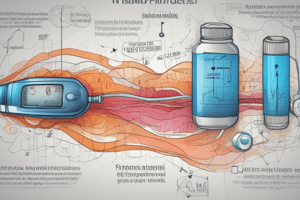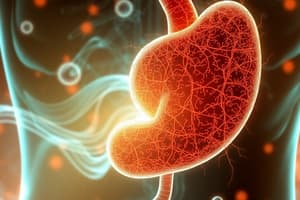Podcast
Questions and Answers
What is the primary purpose of percutaneous transhepatic biliary drainage (PTBD)?
What is the primary purpose of percutaneous transhepatic biliary drainage (PTBD)?
- To increase bile flow
- To drain bile due to distal blockage (correct)
- To perform surgery on the gallbladder
- To reduce bile production
Insulinomas are predominantly malignant tumors.
Insulinomas are predominantly malignant tumors.
False (B)
What is the gold standard test for diagnosing insulinomas?
What is the gold standard test for diagnosing insulinomas?
72-hour fasting test
The most important prognostic factor for surgical outcomes in gastrointestinal surgery is the _____ stage.
The most important prognostic factor for surgical outcomes in gastrointestinal surgery is the _____ stage.
Match the following palliative surgical procedures with their purposes:
Match the following palliative surgical procedures with their purposes:
Which type of tumor is characterized by an ovarian-like stroma and is most common in premenopausal females?
Which type of tumor is characterized by an ovarian-like stroma and is most common in premenopausal females?
Elevated CEA levels are associated with a pseudocyst.
Elevated CEA levels are associated with a pseudocyst.
What is the primary management strategy for a main duct type IPMN that measures greater than 2 cm?
What is the primary management strategy for a main duct type IPMN that measures greater than 2 cm?
The Ohashi Triad includes a dilated hepatopancreatic duct, fish mouth appearance of ampulla, and _____ coming out.
The Ohashi Triad includes a dilated hepatopancreatic duct, fish mouth appearance of ampulla, and _____ coming out.
Match the following tumor descriptions with their characteristics:
Match the following tumor descriptions with their characteristics:
What are the components of the Zollinger-Ellison Triad?
What are the components of the Zollinger-Ellison Triad?
A gastrin level below 1000 pg/mL is considered diagnostic for Zollinger-Ellison syndrome.
A gastrin level below 1000 pg/mL is considered diagnostic for Zollinger-Ellison syndrome.
What type of tumor is associated with the Zollinger-Ellison syndrome?
What type of tumor is associated with the Zollinger-Ellison syndrome?
In a diagnosis of Zollinger-Ellison syndrome, a serum gastrin level greater than ____ pg/mL is considered diagnostic.
In a diagnosis of Zollinger-Ellison syndrome, a serum gastrin level greater than ____ pg/mL is considered diagnostic.
Match the following conditions with their corresponding features:
Match the following conditions with their corresponding features:
Which procedure is associated with a lower chance of dumping syndrome?
Which procedure is associated with a lower chance of dumping syndrome?
The Tunnel of Love refers to the space between the vessels and the pancreas that must be intact for Whipple's procedure.
The Tunnel of Love refers to the space between the vessels and the pancreas that must be intact for Whipple's procedure.
What is the most common cause of death following Whipple's procedure?
What is the most common cause of death following Whipple's procedure?
Chemotherapy with __________ and capecitabine is more effective than Gemcitabine monotherapy.
Chemotherapy with __________ and capecitabine is more effective than Gemcitabine monotherapy.
Match the following complications with their descriptions:
Match the following complications with their descriptions:
Which of the following symptoms is NOT associated with WDHA Syndrome?
Which of the following symptoms is NOT associated with WDHA Syndrome?
Somatostatinomas typically present with diabetes and cholelithiasis.
Somatostatinomas typically present with diabetes and cholelithiasis.
What is the most common site for serous cystic neoplasms in pancreatic tumors?
What is the most common site for serous cystic neoplasms in pancreatic tumors?
The presence of ______ in blood is indicative of non-functional pancreatic endocrine neoplasm.
The presence of ______ in blood is indicative of non-functional pancreatic endocrine neoplasm.
Match the types of pancreatic tumors with their characteristics:
Match the types of pancreatic tumors with their characteristics:
What is the recommended management approach for pancreatic tumors larger than 2 cm?
What is the recommended management approach for pancreatic tumors larger than 2 cm?
Wider resection is recommended for pancreatic tumors smaller than 2 cm.
Wider resection is recommended for pancreatic tumors smaller than 2 cm.
What is the management recommendation for pancreatic tumors larger than 2 cm?
What is the management recommendation for pancreatic tumors larger than 2 cm?
For pancreatic tumors greater than 2 cm, the appropriate management is ______ resection.
For pancreatic tumors greater than 2 cm, the appropriate management is ______ resection.
Match the following tumor sizes with their management recommendations:
Match the following tumor sizes with their management recommendations:
Flashcards are hidden until you start studying
Study Notes
Pancreatic Endocrine Tumor
- Most common endocrine tumor is insulinoma, arising from B-cells
- 90% of insulinomas are benign
- Insulinomas are evenly distributed throughout the pancreas
- Fasting insulin and 72-hour fasting test are methods of investigation
- Endoscopic ultrasound is the best method for localization
- Whipple's triad: fasting hypoglycemia, low blood glucose value, insulin/glucose ratio > 0.3
Zollinger-Ellison Syndrome
- Characterized by increased gastrin, increased acid output, and a non-beta cell tumor
Diagnosis
- Serum gastrin level > 1000 pg/mL is diagnostic
- Gastrin levels should be measured in fasting state and after a meal
Mucinous Tumors
- Located mostly in the body and tail of the pancreas
- More common in premenopausal females
- Often have ovarian-like stroma
- ER and PR receptors are positive
- CEA levels are elevated
- Positive history of pancreatitis
- Differential diagnosis includes pseudocysts which have homogenous appearance and no CEA elevation
Investigation
- CT scans may show egg shell calcification and heterogeneous lining
Intraductal Papillary Mucinous Neoplasm (IPMN)
- Three types: branch duct, main duct, and mixed type
- Mixed type starts in branch duct and progresses to the main duct
- Ohashi Triad: dilated hepatopancreatic duct, fish mouth appearance of ampulla, and mucin coming out
- Diagnosis is made via ERCP
Management
- Resection is recommended for main duct type > 2 cm and branch duct type > 2 cm
Solid Pseudopapillary Tumor / Gruber Frantz Tumor
- Also known as Hamoudi tumor
- More common in females
- Located in the tail of the pancreas
- Mutation: Beta-catenin/Vimentin mutation
- Management: Resection
Whipple Surgery
- Also known as pancreaticoduodenectomy
- Pylorus preserving Whipple: lower chances of dumping syndrome, preferred procedure, involves the pylorus/unattainable margin, leads to a traditional Whipple's procedure
- Incision: Chevron/Roof top
Procedure Details
- Cholecystectomy
- Common Bile Duct (CBD) management
- Pylorus management
- Pancreatectomy
- Duodenectomy
Resected Portion
- Head of the pancreas
- Duodenum
- Distal portion of the common bile duct
- Gallbladder
Additional Procedures
- Hepaticojejunostomy (anastomosis with common hepatic duct)
- Gastrojejunostomy
- Pancreaticojejunostomy
Tunnel of Love
- Space between the vessels and pancreas
- Must be intact for Whipple's procedure
Complications
- Impaired gastric emptying
- Hemorrhage
- Wound infection
- Sepsis due to anastomotic leak (most common cause of death)
Recurrence
- Pancreatic fistula due to pancreatico jejunal anastomotic leak
- Observed on days 2-3 post-operatively
- Turbid drainage rich in amylase
- Typically resolves spontaneously
- Octreotide is effective in managing pancreatic fistulas
Chemotherapy
- Gemcitabine + capecitabine is more effective than Gemcitabine monotherapy
- FOLFIRINOX provides better survival than Gemcitabine monotherapy
Management of Unresectable Tumors
- Palliative care for pruritus and jaundice
- ERCP and stenting
WDHA Syndrome
- Also known as Verner Morrison Syndrome
- Caused by elevated Vasoactive Intestinal Peptide (VIP) due to VIPoma
- Symptoms: watery diarrhea, hypokalemia, achlorhydria, acidosis
Somatostatinomas
- Symptoms: steatorrhea (malabsorption), diabetes, cholelithiasis
Non-Functional Pancreatic Endocrine Neoplasm
- More common in elderly patients
- Usually malignant
- Originates mostly from the head of the pancreas
- Presence of chromogranin A and synaptophysin in the blood
- Management: Resection
Cystic Neoplasms
- Serous Cystic Neoplasms
- Most common site: head of the pancreas
- Seen in older patients
- Presence of glycogen-rich cells
- CEA levels are not raised
- Large, multilocular mass
- Usually benign
- Clinical Features:
- Mass
- Pain
- Investigation
- CECT: IOC (Imaging of Choice)
- Sunburst Appearance
- Management:
- Large & symptomatic → Enucleation
- Small & asymptomatic → Observation
Studying That Suits You
Use AI to generate personalized quizzes and flashcards to suit your learning preferences.




